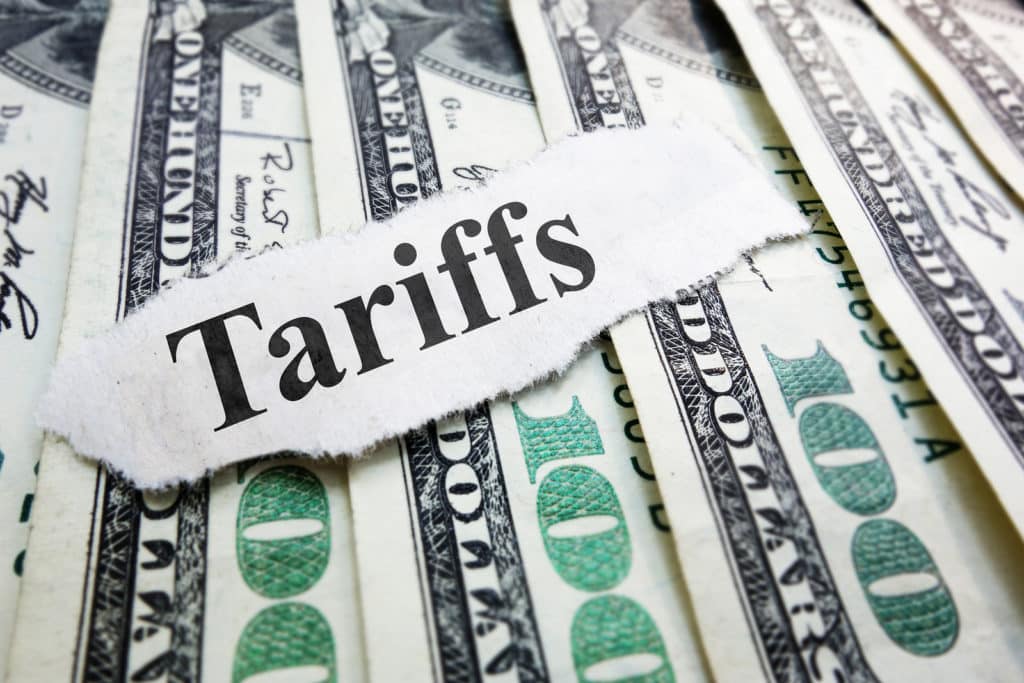The Economic Fallout: Tariff Shock And Bond Market Instability

Table of Contents
Understanding the Tariff Shock Mechanism
The mechanism of a Tariff Shock is complex, involving interconnected effects across various economic sectors. Let's examine three key areas:
Inflationary Pressures
Tariffs directly increase the cost of imported goods. This translates to higher consumer prices, reducing purchasing power and impacting consumer confidence. For example, tariffs on steel and aluminum have led to increased costs for manufacturers using these materials, ultimately increasing the price of finished goods like cars and appliances.
- Increased consumer prices: Higher prices for imported goods directly affect consumers' budgets.
- Reduced consumer spending: Inflationary pressures erode purchasing power, leading to decreased consumer spending.
- Business cost increases: Businesses face higher input costs, potentially leading to reduced investment and job losses.
- Examples: Tariffs on steel impacted the automotive industry, while tariffs on textiles increased clothing prices.
This inflationary pressure can trigger a wage-price spiral, further exacerbating the economic instability caused by the Tariff Shock. Central banks may face a difficult dilemma: combat inflation by increasing interest rates, potentially slowing economic growth, or allow inflation to rise, risking further instability.
Supply Chain Disruptions
Tariffs disrupt established international trade patterns, leading to delays and uncertainty in global supply chains. Businesses may need to find alternative suppliers, facing increased costs, logistical challenges, and potential quality control issues.
- Delayed shipments: Tariffs can cause delays in shipping and customs processing, disrupting production schedules.
- Increased sourcing costs: Businesses must invest time and resources in finding new suppliers, increasing costs.
- Impact on just-in-time inventory: The efficiency of just-in-time inventory management is severely compromised, leading to potential stockouts or overstocking.
- Industry impact: Industries heavily reliant on global supply chains, such as electronics and automotive manufacturing, are particularly vulnerable.
The complexity of modern supply chains makes them incredibly sensitive to trade disruptions, highlighting the pervasive impact of a Tariff Shock. Companies must develop strategies to improve supply chain resilience in the face of trade uncertainty.
Currency Fluctuations
Tariff disputes often lead to significant fluctuations in exchange rates. A nation imposing tariffs might experience a devaluation of its currency, making its exports cheaper but simultaneously making imports more expensive.
- Currency devaluation: Tariffs can weaken a nation's currency, impacting its trade balance.
- Export competitiveness: Devaluation can boost export competitiveness, but only if domestic production can keep pace with demand.
- Import costs: Imports become more expensive, contributing to inflationary pressures.
- Currency wars: Retaliatory tariffs can trigger currency wars, further destabilizing the global economy.
- Examples: The US-China trade war saw significant fluctuations in the value of the US dollar and the Chinese yuan.
Currency fluctuations amplify the destabilizing effects of a Tariff Shock, creating further uncertainty for businesses engaged in international trade.
Bond Market Instability in the Face of Tariff Shock
The uncertainty generated by a Tariff Shock significantly impacts the bond market, leading to instability and increased risk aversion.
Increased Uncertainty and Risk Aversion
Increased uncertainty surrounding future trade policies makes investors more risk-averse. This flight to safety drives investment towards government bonds, considered less risky assets.
- Demand for safe assets: Investors move from riskier assets into government bonds, pushing up bond prices.
- Lower bond yields: The increased demand pushes down bond yields, impacting returns for investors.
- Impact on different bond types: Government bonds see increased demand, while corporate bond yields might increase to compensate for increased risk.
Impact on Interest Rates
The increased demand for safe assets can push down interest rates, potentially impacting borrowing costs for businesses and consumers. However, lower rates may not stimulate economic growth if businesses are reluctant to invest due to uncertainty.
- Lower borrowing costs: Lower interest rates can reduce the cost of borrowing for businesses and consumers.
- Monetary policy challenges: Central banks may struggle to stimulate economic growth through monetary policy if uncertainty prevails.
- Potential for liquidity crisis: Extreme uncertainty can lead to a freeze in credit markets, making it difficult for businesses to access funds.
Credit Rating Downgrades
Increased economic uncertainty can lead to credit rating agencies downgrading the creditworthiness of corporations and even nations, impacting their borrowing costs and access to credit.
- Increased borrowing costs: Downgrades increase borrowing costs, making it more expensive for businesses to finance operations.
- Limited access to credit: Downgraded companies may face difficulties securing loans or raising capital.
- Impact on bond yields: Downgrades increase the yield demanded by investors on corporate bonds to compensate for the increased risk.
- Examples: Several companies experienced credit rating downgrades during periods of heightened trade tensions.
These downgrades further amplify the negative consequences of a Tariff Shock, hindering economic growth and creating a vicious cycle of uncertainty and decreased investment.
Conclusion
The "Tariff Shock" presents a significant challenge to global economic stability. Its impact on inflation, supply chains, currency markets, and the bond market creates a complex and interconnected web of consequences. Understanding the mechanism of a Tariff Shock and its ramifications on various economic sectors is crucial for businesses, investors, and policymakers. To mitigate the negative effects of future Tariff Shocks, proactive policy responses that promote free trade and reduce economic uncertainty are necessary. Further research into the long-term effects of protectionist policies on global economic growth is imperative. Stay informed about the ongoing developments in global trade and the evolving impact of Tariff Shock to protect your investments and navigate these challenging economic times. Understanding the dynamics of a Tariff Shock is key to mitigating its impact on your portfolio and business operations.

Featured Posts
-
 January 6th Falsehoods Ray Epps Defamation Suit Against Fox News Explained
May 12, 2025
January 6th Falsehoods Ray Epps Defamation Suit Against Fox News Explained
May 12, 2025 -
 Can Colton Herta Find The Pace At Barber A Critical Race Preview
May 12, 2025
Can Colton Herta Find The Pace At Barber A Critical Race Preview
May 12, 2025 -
 Updated Injury Report Yankees Vs Giants Series April 11 13
May 12, 2025
Updated Injury Report Yankees Vs Giants Series April 11 13
May 12, 2025 -
 Belal Muhammad Vs Jack Della Maddalena Ufc 315 Faceoff Incident
May 12, 2025
Belal Muhammad Vs Jack Della Maddalena Ufc 315 Faceoff Incident
May 12, 2025 -
 Jurickson Profar Receives 80 Game Ped Suspension What It Means For His Career
May 12, 2025
Jurickson Profar Receives 80 Game Ped Suspension What It Means For His Career
May 12, 2025
Latest Posts
-
 Herthas Crisis Boateng And Kruse Offer Contrasting Viewpoints
May 13, 2025
Herthas Crisis Boateng And Kruse Offer Contrasting Viewpoints
May 13, 2025 -
 The Boateng Kruse Debate Understanding Herthas Struggles
May 13, 2025
The Boateng Kruse Debate Understanding Herthas Struggles
May 13, 2025 -
 Razreshenie Na Religioznuyu Deyatelnost Dlya Rpts V Myanme
May 13, 2025
Razreshenie Na Religioznuyu Deyatelnost Dlya Rpts V Myanme
May 13, 2025 -
 Boateng And Kruse Clash Over Hertha Berlins Poor Form
May 13, 2025
Boateng And Kruse Clash Over Hertha Berlins Poor Form
May 13, 2025 -
 Hertha Bscs Woes Boateng And Kruses Differing Perspectives
May 13, 2025
Hertha Bscs Woes Boateng And Kruses Differing Perspectives
May 13, 2025
